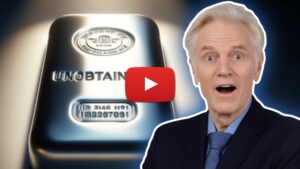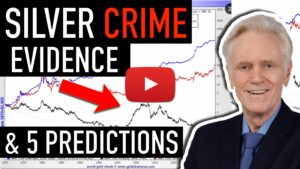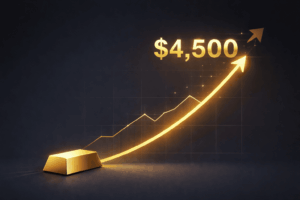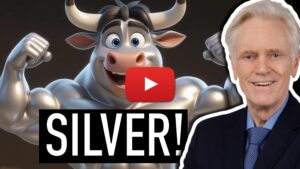From the Hidden Secrets of Value series with Alan Hibbard
Most people believe they’re saving money.
But what they’re really saving… is currency — and that simple confusion can destroy a lifetime of work.
In Hidden Secrets of Value, Episode 2: Money vs. Currency, Alan Hibbard revisits one of history’s most powerful lessons — and exposes the same threat hiding inside our modern financial system.
The Lesson of the $100 Million Loaf of Bread
Alan begins with a story most of us remember from high school: Germany’s Weimar hyperinflation.
Before the collapse, a loaf of bread cost one mark. Within a year, it cost billions.
It wasn’t greed or bad policy alone — it was the fatal mistake of relying on currency that could be printed without limit.
As more marks flooded the system, every existing mark lost purchasing power. The database of value — who worked, who produced — became meaningless.
Alan asks the question few dare to consider:
“If that could happen in Germany, could it happen in America?”
The Difference Between Money and Currency
Currency can be printed out of thin air. Money must be earned into existence.
Currency moves easily — it’s made for transactions. Money stores value — it’s made to hold wealth.
Think of it like this:
- Currency is your car — designed to move.
- Money is your house — designed to protect.
Both serve a purpose, but use them wrong and you pay the price. Holding a currency long-term is like living in your car — uncomfortable, unstable, and ultimately costly.
The Honest Database
Elon Musk once called money “an entry in a database” — and he’s right. Your bank balance is just a number in a system, tracking who owns what.
But Alan adds the critical question: Is the database honest?
When you earn a $20 bill, the system records that you created $20 worth of value for someone. That’s fair. That’s how it’s supposed to work.
But when central banks create trillions of new dollars with a keystroke, they’re not recording new value — they’re duplicating old entries. Your $20 is still in the database, but now there are millions more $20 bills that weren’t earned. The ledger lies.
Gold and silver can’t lie. They can’t be copied or inflated away. Every ounce exists because someone did the actual work to pull it from the earth. It’s a ledger that can’t be hacked.
Why the Dollar Isn’t a Store of Value
Most people use the dollar for everything — saving, investing, and spending. But that’s not what it’s built for.
The U.S. dollar is a medium of exchange, not a store of value. It was never meant to preserve purchasing power over time.
When governments and central banks create more currency, every dollar you hold loses a little bit of its ability to buy what you need. Prices rise — not because things become more valuable, but because your dollars buy less.
Gold and silver, on the other hand, are money. They keep their value precisely because no one can create them out of thin air.
Gresham’s Law: The Free Market’s Final Verdict
There’s a reason you’ve never paid for groceries with your grandmother’s gold ring.
You instinctively know: spend the paper, save the gold.
That’s Gresham’s Law — and it explains why the world spends paper and holds gold.
In every society, people instinctively keep what’s most valuable. People spend the weaker asset and hoard the stronger one. That’s why gold and silver have remained money for thousands of years, long after every currency has failed.
If You Remember One Thing, Remember This
Alan’s message is simple — and urgent:
If you store your wealth in currency, you’re holding something built to lose value over time.
To protect what you’ve earned, you need to hold money — real, tangible assets with built-in honesty.
🎥 Watch the full episode:
Hidden Secrets of Value — Episode 2: “Money vs. Currency”
People Also Ask
What’s the difference between money and currency?
Currency serves as a medium of exchange — it moves easily, and governments can print or create it at will. Money, on the other hand, stores value because people must earn it into existence, like gold or silver. Alan Hibbard explains the difference — and why it matters — in Hidden Secrets of Value, Episode 2.
Why does paper money lose value over time?
Paper money, or fiat currency, loses value because governments can create unlimited amounts of it. When more currency enters circulation, the existing supply buys less — a process called inflation.
Could hyperinflation happen in the United States?
Yes — any country using an unbacked fiat currency is vulnerable to inflation or hyperinflation. As Alan notes, when the U.S. abandoned the gold standard in 1971, it removed the natural limit on currency creation. Watch how this shift impacts your savings in Money vs Currency.
Why is gold considered “honest money”?
People call gold “honest money” because it represents real work and no one can print it out of thin air. It verifies its own value by reflecting genuine production and effort — unlike currency, which governments can create by decree.
How can I tell if something is a store of value or just a currency?
If an asset holds its purchasing power over time, it’s a store of value. If people design it to circulate and it loses value the longer you hold it, it functions as a currency.. The free market reveals the truth — people hoard what’s most valuable and spend what’s weakest. Watch Alan break down this idea in Hidden Secrets of Value – Episode 2.
Get Gold & Silver Insights Direct to Your Inbox
Join thousands of smart investors who receive expert analysis, market updates, and exclusive deals every week.









